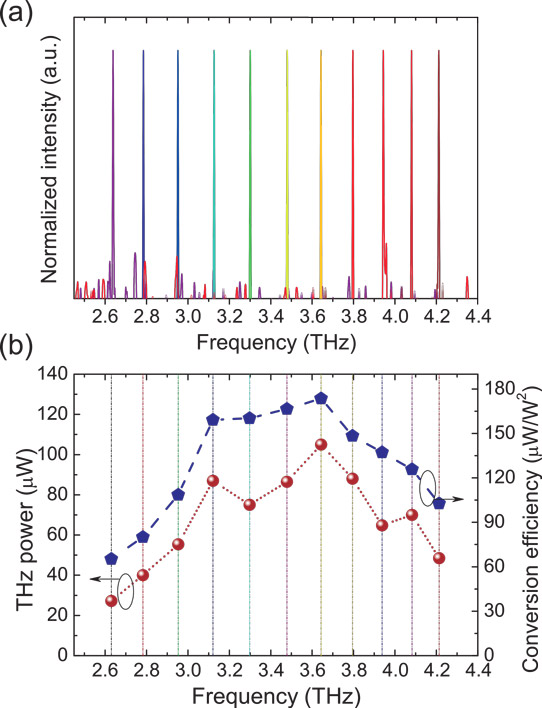- News
11 December 2014
Terahertz radiation from mid-infrared quantum cascade lasers
Northwestern University’s Center for Quantum Devices in USA has developed a monolithic room-temperature terahertz (THz) source based on quantum cascade lasers (QCLs) [Q. Y. Lu et al, Appl. Phys. Lett., vol105, p201102, 2014]. The resulting device is tunable over the range 2.6THz-4.2THz, i.e. 47% of the central frequency.
The researchers comment: “This dramatic increase in the tuning range compared with any other electrically tunable THz source will lead to new opportunities for THz spectroscopy and sensing.”
Many biochemical molecules have strong spectral fingerprints in the THz region. In astronomical research, the interstellar medium contains a number of atomic and molecular emission lines in the THz range.

Figure 1: (a) Schematic of three-section device. (b) SGDFB and DBR reflectivity spectra corresponding to calculated gain spectra at 0V (green line) and 12V (purple line) biases. (c) Detailed view of SGDFB reflectivity combs.
The device consisted of mid-infrared (mid-IR) QCL devices with two sampled grating distributed feedback (SGDFB) and one distributed bragg reflector (DBR) sections (Figure 1a). The THz radiation was produced through intracavity difference frequency generation (DFG) from two mid-IR QCL regions in the structure.
The wavelength of one QCL was controlled by the DBR. The other QCL wavelength was controlled by the SGDFB sections.
The team claims that the device is the first room-temperature, multi-section, two-color SGDFB-DBR structure to realize a monolithic tunable THz source.
The DBR had patterned grating lines with a uniform period. The DFB section was electrically isolated and wavelength tuning was provided by a DC bias that affected the refractive index of the DBR material. The wavelength tuning of the DBR had limited range.
The SGDFB structures were more complicated, with series of short gratings giving a comb-like reflectivity response with wavelength (Figure 1b). Again, biasing gave tuning of the reflectivity with wavelength. The interplay of the two SGDFB sections gives a Vernier-type tuning mechanism. The tuning is not continuous, but the gaps could be filled by nudging the DBR reflection maximum or by changing the biases on the SG1 and SG2 sections simultaneously.
The QCL wafer that was used had a broadband dual-core active region. The material had large optical non-linearity in the 1-5THz range to enable DFG. The gratings were etched into a 500nm InGaAs layer located about 100nm from the active core.
The reflectivity peak of the SGDFB combs was arranged to be close to that of the gain peak of the laser core. The DBR peak corresponded to a gain at 75-80% of the maximum.
The material was formed into double-channel ridge waveguide laser diodes. The ridge was 22μm wide. The laser sections were electrically isolated by etched 2μm-deep channels. The final laser bars were 6.3mm long: 1mm for the DBR, 2mm for SG1, and 3.3mm for SG2 and an amplifying section. The bar was coated with 1.1μm yttrium oxide as an anti-reflective layer. The front facet for THz-out-coupling was polished at a 30° angle with the cleavage plane.
The device was mounted epi-up on a copper heat-sink. The bond between device and heat-sink was indium solder. Testing was performed with pulsed mode operation. The QCL structure was designed for epi-down mounting and the epi-up configuration was likely to suffer from thermal management problems.
The tuning injection current of the SG1 and SG2 sections was in the ranges 40mA-290mA and 40mA-360mA, respectively. The DBR bias resulted in 50mA current injection. The reflectivity of the DBR section was somewhat affected by the biasing on the other sections, particularly on the adjacent SG1. The heating of the DBR from self-heating of SG1 also shifted the DBR reflectivity maximum.
The total power of the mid-IR radiation was 1.32W-1.58W. With the two SGDFB sections connected at the same bias the output was 2.1W with current density threshold for lasing of 3.18kA/cm2. Connecting the DFB to SG1 and SG2 gave 2.7W with 3.0kA/cm2 threshold.
THz output was available in the range 2.6THz-4.2THz, i.e. 47% of the central frequency (Figure 2). The peak performance was in the range 3.2THz-3.8THz. The output power was 26μmW at 2.6THz and 105μmW at 3.64THz.

Figure 2: (a) Combined THz spectra obtained via Vernier tuning mechanism. (b) THz power and conversion efficiency in tuning range as a function of THz frequency.
The researchers believe: “Higher THz power and continuous-wave operation can be further obtained by using a device structure with a higher THz conversion efficiency and better thermal packaging.”
The devices broke down under 13V bias, corresponding to 850mA-900mA injection. The breakdown input power was ~11.5W.
Mid-infrared quantum cascade lasers InGaAs
http://dx.doi.org/10.1063/1.4902245
The author Mike Cooke is a freelance technology journalist who has worked in the semiconductor and advanced technology sectors since 1997.


